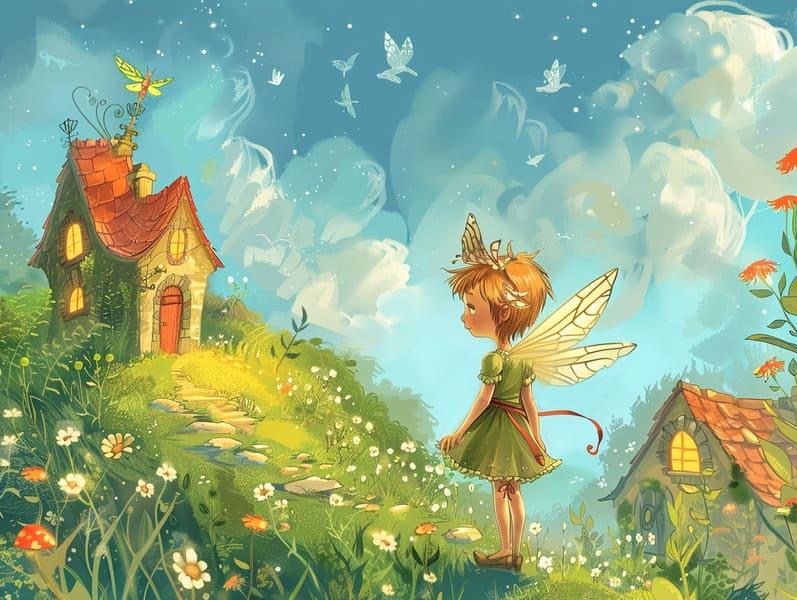The Emergence of Fairy Tales and Its Eternal Fascination.
The Emergence of Fairy Tales and Its Eternal Fascination.
Blog Article

Fairy tales for kids have enduring presence. These tales have been whispered from one generation to the next centuries before they were ever published. They emerged from a variety of traditions, including Eastern traditions. They were initially conveyed among elders, often carrying themes and messages mirroring the societal norms and beliefs of the time.
The Grimm brothers, Jacob and Wilhelm, were among the first to collect and release many of these beloved stories. Their anthology, "Grimm's Children's Stories," included tales like "The Story of Cinderella," "The Bread Crumb Trail," and "The True Story of Snow White," which have since become mainstays in the world of famous fairy tales. Similarly, Andersen's fanciful tales, such as "The Mermaid," and "The Duckling that Could," have captured hearts worldwide, securing their place in the pantheon of treasured fairy tales.
Though they are old, traditional fairy tales remain as meaningful as ever, especially as bedtime stories for kids. These magical stories are now available in many formats, including vibrantly illustrated books, delightful animations, and free fairy tales online.
Their persistent charm can be linked to several fascinating points:
Vital Lessons: Ancient fairy tales often present important moral lessons. Tales like "The Boy Who Cried Wolf" teach the significance of honesty, while "The Tale of the Tortoise and the Hare" show the merits of steadfastness and unpretentiousness. These stories offer young ones clear distinctions between right and wrong, shaping their moral compass in a mild yet impactful way.
Compassion and Insight: Ancient fairy tales frequently involve protagonists facing trials and tribulations, inspiring readers to relate with their struggles and support their triumphs. For instance, "Beauty and the Beast" highlights the necessity of seeing inner beauty to understand the true essence of a character, nurturing insight and perception.
Cultural Appreciation: Many ancient fairy tales are imbued with the cultural contexts from which they came. Reading these tales can provide delightful insights into different heritages, encouraging a sense of cultural insight and discernment.
Inventiveness and Fantasy: The imaginative elements in classic fairy tales—spells and potions—encourage children’s inventiveness. These narratives bring readers to fantasy realms, encouraging innovative dreams and a sense of amazement that lasts a lifetime.
Traditional fairy tales are not only mesmerizing but also edifying. They serve as spellbinding tools in building various intellectual and emotional capacities in children. When traditional fairy tales are told out loud, they promote verbal development by presenting new lexicon and complicated sentence structures. This practice also cultivates auditory perception and attentiveness, as the young track the narrative, eager to see what happens next.
Furthermore, examining the themes and characters of old fairy tales can sharpen analytical skills and thinking skills. Young ones learn to pinpoint patterns, guess what will happen, and understand cause and effect. These contemplations also facilitate children speak out their thoughts and feelings, nurturing their emotional intelligence.
In today’s modern era, the accessibility of digital storybooks has made these stories more acquirable than ever. Websites and programs make available wide arrays of ancient fairy tales that can be viewed or heard anytime, anywhere. Fairy tales narrated are particularly well-received, making available an interactive method for young readers to enjoy these spellbinding stories. Audio stories and spoken videos lead characters and settings to life, often augmented by magical music and harmonies that elevate the story journey.
The unending appeal of traditional fairy tales lies in their ability to alter to modern times while maintaining their basic principles. Contemporary revisions of these narratives often integrate more representative figures and modern settings, making them accessible to today’s audience. However, the main ideas of heroism, kindheartedness, and impartiality remain unchanged, continuing to touch young listeners of all ages.
Traditional fairy tales also offer a sense of familiarity and recognition. They highlight a structured narrative with a clear beginning, middle, and end, often drawing to a close with the finalization of conflicts and the triumph of virtue over corruption. This steadiness can be solacing for young readers, furnishing a sense of stability in an inconstant world.
Ancient fairy tales continue to entrance and enlighten new generations, maintaining their enchantment and pertinence in modern society. As nighttime stories for kids, they disclose a perfect blend of charm and understanding, facilitating moral values, empathy, and creativity. The abundance of online storybooks and the sought after status of fairy tales recited affirm that these traditional stories remain reachable to new generations.
By safeguarding and relating these fairy tales, we continue to pay tribute to the rich tapestry of cultural legacy and cultural heritage. Whether these guys you are enjoying a artistically illustrated book, viewing a digital collection, or listening on an narrated book, the radiance of famous fairy tales is always within reach. These stories remind us of the invariable strength of narratives and its ability to gather us across centuries and lands.
Whether you are viewing a beautifully illustrated book, enjoying a electronic collection, or listening to an spoken story, the beauty of traditional fairy tales is always within reach.
These tales emphasize of the steadfast impact of stories and its ability to connect us across eras and regions, casting a charm that captivates and teaches alike.